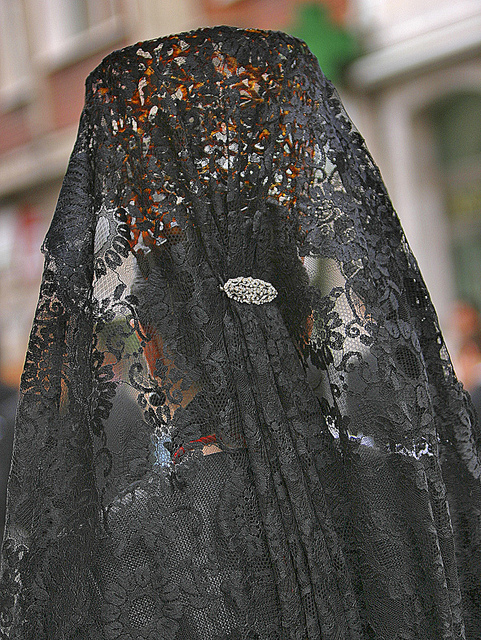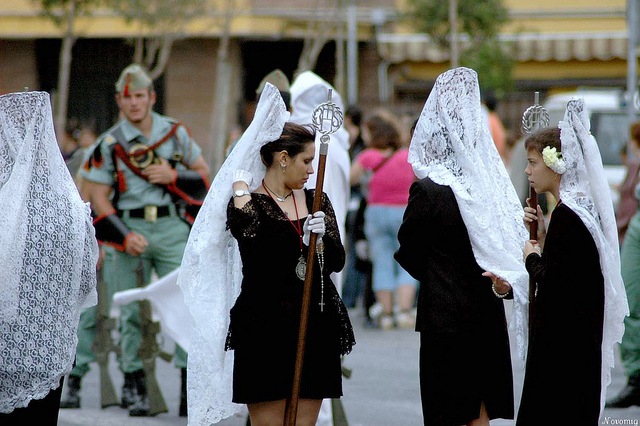Spain is a country of traditions, some are retained and others lost. But, undoubtedly, an important tradition, that is few times used is The Mantilla. Possibly the origin of this little blanket back to the time of the Iberians, that it was customary for women to cover their heads with veils or cloaks. Later, during the Middle Ages, it was still employed in the Iberian peninsula touched different head coverings.
In the seventeenth century, it was common to use the blanket and lace as well as the distinctive garment of cloth and silk. However, its use is not widespread among women of high position well into the eighteenth century, as seen in numerous paintings by Francisco de Goya, which is used much less than formerly, is La Mantilla.

MANTILLA, by Alfredo Miguel Romero, at flickr.com
His older roots, however, was reached in the nineteenth century's predilection powered by Isabel II of Spain towards her. Currently the Queen Sofia and her daughters also used to take it when they dressed in elegance.
In the twentieth century, the Mantilla was losing popularity except in some regions such as Madrid, Valencia and Andalusia, where it soon disappeared. Currently, its use has been restricted to certain events like Easter processions, offerings of flowers at parties, weddings with elegance.
We know that the original use of the Mantilla was as an ornamental piece in the wardrobe woman. But this piece evolved and its evolution was marked by social, religious and even weather. The latter was visible in the type of preparation. In the North, woven fabrics were used, with a clear purpose: to serve warm. In the south, tissues were used for purely ornamental purposes, such as silk.
Early, uses of the Mantilla were between people. Were not used by the upper classes or Aristocracy. They were used more as a blanket coat as an ornamental garment, without using the comb.
In the early seventeenth century, began an evolution of the Mantilla giving way to a more ornamental piece in the women's locker room, to replace gradually the lace cloth. Little by little, starts to spread the use of this garment as an ornament, but would have to wait until well into the eighteenth century that the blanket begins to be used for the upper classes.
The Queen Elizabeth II (1833-1868), very fond of the use of headdresses and tiaras, begins to popularize the use of the Mantilla, custom soon adopt women closest to her. Courtesans and higher social strata ladies begin to use this piece in various social events, which contributes largely to give a distinguished air, as it has come down to us (although its use is very limited and little generalized).
Its use has a clear setback, with the death of the sovereign, while maintaining a certain rootedness in the center and south of Spain. As we can see, it remains its use in places where the use has nothing to do as warmer clothes but merely ornamental. Even today this custom lasts and is easier to see Mantillas in the center or south of our country in the north.
The reduced use of the Mantilla in following times of the reign of Isabel II, has, among other reasons, its origin in the use of other customs imposed by the new monarchs. A remarkable fact is known as "the conspiracy of the Mantillas”: a form of protest by the Spanish women against the new foreign customs that seemed to want to impose the King Amadeo I of Spain (Amadeo of Saboya 1845-1890) and his wife Maria Victoria. Amadeo I abdicated the throne of Spain after a short time (about three years), due to the "lawlessness" of the Spaniards.
In the late nineteenth and early twentieth century, the Mantilla still a piece of "everyday" use event and it begins its decline. Just a little "Mantilla", that usually use the ladies in the church, which was known as "shawl" (handkerchief, usually triangular, that women are placed in the head) is preserved. We can indicate that it is a "reduced" version of the Mantilla, dressing without comb.
Currently, the Mantilla can be seen, almost exclusively, in bulls, Holy Week and weddings. It is not easy to see it in other events or ceremonies.
For any type of event (wedding, bulls ...) the Mantilla must have the proper length to each person. On the front, it should have a length to the height of the hands, and the back, long fingers below the waist level. To avoid the "wings" of the Mantilla, it should hold the dress discreetly (usually on shoulders).
The stylists say a trick to make a perfect fit with enough "slack" is tilt your head to the left side, and holding the Mantilla right shoulder and back (tilt your head to the right and hold the Mantilla on the shoulder left).
For Mantillas there are several types of tissue, depending on budget and taste of every woman:
Lace: it is a type of silk, characterized by the use of large grounds, especially floral, which is made in silk brighter than the rest of the Mantilla (which is usually done on silk matte to highlight more embroidery). It has a particular characteristic, which are ripples of its edges, which some authors have called "castanets tips", because of its similarity to these.
Chantilly: as the name suggests, they use a tissue from this French city, light and elegant. Like the rest of the Mantillas, it is usually heavily embroidery with various motives.
Tul: is a thin and transparent fabric, of silk, linen or cotton, and we can say that crossed over "current" for Mantillas. Often used as an imitation of Mantillas of lace and chantilly. These are known as Mantillas of lace.
As for the comb, we opt for a suitable match us and our "relationship", if we are accompanied. The best are the hawksbill, although there are other varieties. If you are petite, you can choose a high comb, but it is more difficult to wear. If you are tall, and have a long face, you can choose a lower (and more comfortable to wear) comb. In any case, you have to adjust well to the bun and cover it properly and well balanced with the Mantilla.
To show off a wedding Mantilla, some tips. If the wedding is during the day, you can wear the Mantilla with a cocktail dress --below the knee--. If you are the maid of honour, you can wear a long dress, even if it is in the morning. Do not wear a short dress. If the wedding is in the evening, it will only be wearing long dress. Keep in mind two things: one is dressed in religious ceremonies (if the wedding is civil, it is best to forget the Mantilla), and certain etiquette wedding (when dresses evening dress or tuxedo, the groom). Finally, colors. According to tradition, the white or ivory Mantilla is only wear by single women and black Mantilla is reserved for married (although like many other customs or traditions, is not kept in mind).

Melilla en Semana Santa (21), Melilla, South eastern Spain, by Miguel GonzalezNovo, at flickr.com
Well, I hope that you have enjoyed with this post.
Till next time, kind regards,
Luis.
Sponsored by Costaluz Lawyers.
Please click down here:
